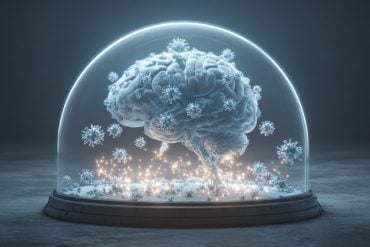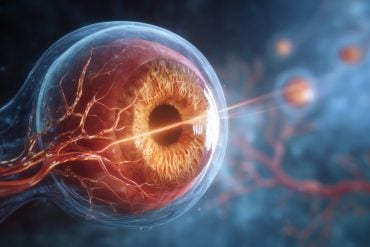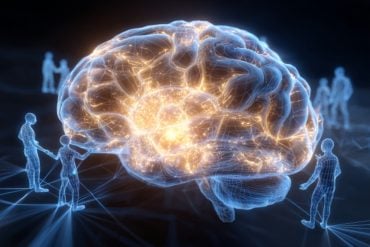Summary: A new study shows that specific brain cells called PV interneurons play a crucial role in social decision-making and empathy. When researchers suppressed these neurons in mice, the animals stopped differentiating between familiar and unfamiliar peers and failed to show preference for distressed companions.
This suggests PV interneurons act as a switch in social circuits, influencing how animals choose their social targets. The findings could shed light on the neural roots of autism and schizophrenia, where PV interneuron dysfunction has been observed.
Key Facts
- Social Switch Cells: PV interneurons control whether animals show empathy or recognize familiar peers.
- Behavioral Effects: Inhibited mice treated strangers and peers the same and ignored stressed companions.
- Clinical Relevance: Abnormalities in these cells are also seen in autism and schizophrenia.
Source: Kobe University
Social interactions abound with decisions: How much time do we spend with a friend? Do we prioritize time with a friend who looks distressed?
Like for all behavior, there are specialized clusters of neurons in the brain that are responsible for fine-tuning such complex behavior, and it is known that developmental defects in these areas are related to neuropsychiatric disorders such as autism spectrum disorder or schizophrenia.

Kobe University neuroscientist TAKUMI Toru has a long history of research on discovering the neurological basis of these disorders.
He says, “We have previously identified in mice a neuron cluster that’s active during social interaction and now we wanted to clarify the role of a specific kind of signal-modulating cell, so-called ‘PV interneurons,’ that we knew are there.”
Using an endoscopic camera with its lens implanted directly into the brain of genetically modified mice, Takumi’s team was able to record in real time which neurons were active during different activities.
In addition, they also introduced genetic modifications that allowed them to specifically tune down the activity of the target neurons.
In the scientific journal Cell Reports, the Kobe University neuroscientists, in collaboration with SATO Masaaki of Kyoto Institute of Technology, now report that mice whose PV interneurons were inhibited exhibited two interesting behavioral characteristics.
First, they failed to become familiar with their peers. Normal mice spend less time with individuals they already know than with strangers they meet for the first time, but the ones with inhibited PV interneurons would spend just as much time with peers as with strangers.
And second, normal mice, when given the choice between two peers, one stressed and one unstressed, would spend more time with the stressed one. The inhibited mice, however, did not exhibit this consolation behavior.
“Our findings are the first to demonstrate that these particular cells act as a switch in the ‘social cell’ network to control empathetic behavior,” explains Takumi.
In a separate experiment, where mice were allowed to freely interact with individuals they met for the first time, inhibited mice did not exhibit any differences from normal ones.
This demonstrates that the role of PV interneurons is not so much connected to social behavior in general, but in modulating the preference for social targets and thus in making social choices.
Takumi says about the wider implications of this study: “This finding is an important step toward understanding the neural basis of human sociality. Abnormalities in PV interneurons have been reported in model animals and patient brains with autism spectrum disorder and schizophrenia. In the future, further comparative studies between mice and humans may lead to new treatment strategies.”
Funding: The Japan Society funded this research for the Promotion of Science (grants 23K27359, 24H02315, 23K14673, 24H00904, 23H04233, 23KK0132, 24K22036, 24H00620, 24H01241), the Japan Agency for Medical Research and Development (grant JP21wm0425011), the Japan Science and Technology Agency (grants JPMJMS2299, JPMJMS229B), the National Center of Neurology and Psychiatry (grant 6-9), the Takeda Science Foundation and the Taiju Life Social Welfare Foundation. It was conducted in collaboration with researchers from Hokkaido University and the Kyoto Institute of Technology.
About this empathy and social neuroscience research news
Author: Daniel Schenz
Source: Kobe University
Contact: Daniel Schenz – Kobe University
Image: The image is credited to Neuroscience News
Original Research: Open access.
“Parvalbumin interneurons in the insular cortex control social familiarity and emotion recognition” by TAKUMI Toru et al. Cell Reports
Abstract
Parvalbumin interneurons in the insular cortex control social familiarity and emotion recognition
The insular cortex is involved in various aspects of social behavior, yet the role and mechanism of its inhibitory regulation remain unclear.
Through cell-type-specific microendoscopic calcium imaging and chemogenetic manipulation of neuronal activity, we discovered that parvalbumin-positive interneurons (PVINs) in the agranular insular cortex (aIC) are crucial in governing social familiarity and emotion recognition.
Like pyramidal neurons (PNs), a specific subset of PVINs showed increased activity during peer interactions.
Inhibiting PVINs led to a failure in losing the preference for familiar peers and hindered the rise in interactions with stressed individuals.
These changes in behavior were linked to alterations in the proportion of PNs that showed activity corresponding to interactions with significant peers and the transitions in their social target specificity across sessions.
Our findings highlight that PVINs provide context-dependent control over socioemotional behavior and the coding of social information by locally adjusting the social preference of individual PNs in the aIC.






